

Spanish missions in California. A view of Mission San Juan Capistrano in April 2005.
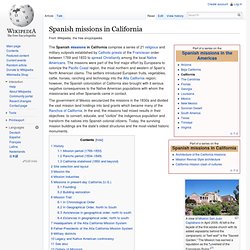
Didacus of Alcalá. Didacus of Alcalá, (or the more familiar Spanish: Diego), also known as Diego de San Nicolás, was a Spanish lay brother of the Order of Friars Minor who served as among the first group of missionaries to the newly conquered Canary Islands.
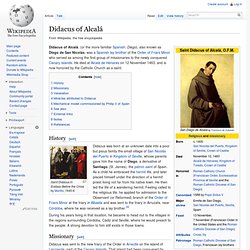
He died at Alcalá de Henares on 12 November 1463, and is now honored by the Catholic Church as a saint. History[edit] Saint Didacus in Ecstasy Before the Cross by Murillo, 1645-6 Didacus was born at an unknown date into a poor but pious family the small village of San Nicolás del Puerto in Kingdom of Seville, whose parents gave him the name of Diego, a derivative of Santiago (St. James), the patron saint of Spain. During his years living in that location, he became to head out to the villages in the regions surrounding Córdoba, Cádiz and Seville, where he would preach to the people. Missionary[edit] A chapel, the Ermita de San Diego, was built in Didacus' birthplace between 1485 and 1514 to enshrine his remains in his native town.[2][3]
Thomas Aquinas. He was the foremost classical proponent of natural theology, and the father of Thomism.
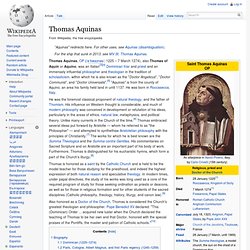
His influence on Western thought is considerable, and much of modern philosophy was conceived in development or refutation of his ideas, particularly in the areas of ethics, natural law, metaphysics, and political theory. Unlike many currents in the Church of the time,[6] Thomas embraced several ideas put forward by Aristotle — whom he referred to as "the Philosopher" — and attempted to synthethise Aristotelian philosophy with the principles of Christianity.[7] The works for which he is best known are the Summa Theologica and the Summa contra Gentiles.
His commentaries on Sacred Scripture and on Aristotle are an important part of his body of work. Furthermore, Thomas is distinguished for his eucharistic hymns, which form a part of the Church's liturgy.[8] Quinque viae. The Quinque viæ, Five Ways, or Five Proofs are five arguments regarding the existence of God summarized by the 13th century Roman Catholic philosopher and theologian St.

Thomas Aquinas in his book, Summa Theologica. They are not necessarily meant to be self-sufficient “proofs” of God’s existence; as worded, they propose only to explain what it is “all men mean” when they speak of “God”. Many scholars point out that St. Thomas’s actual arguments regarding the existence and nature of God are to be found liberally scattered throughout his major treatises, and that the five ways are little more than an introductory sketch of how the word “God” can be defined without reference to special revelation (i.e., religious experience).
Genius. A genius is a person who displays exceptional intellectual ability, creativity, or originality, typically to a degree that is associated with the achievement of an unprecedented leap of insight.
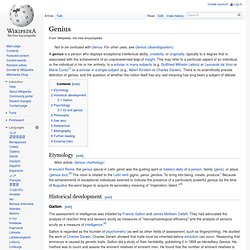
This may refer to a particular aspect of an individual, or the individual in his or her entirety; to a scholar in many subjects (e.g. Gottfried Wilhelm Leibniz or Leonardo da Vinci or Marie Curie)[1] or a scholar in a single subject (e.g., Albert Einstein or Charles Darwin). There is no scientifically precise definition of genius, and the question of whether the notion itself has any real meaning has long been a subject of debate. Etymology[edit] Historical development[edit] Galton[edit] The assessment of intelligence was initiated by Francis Galton and James McKeen Cattell. Tutelary deity. A tutelary (also tutelar) is a deity or spirit who is a guardian, patron or protector of a particular place, geographic feature, person, lineage, nation, culture or occupation.
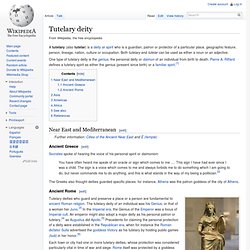
Both tutelary and tutelar can be used as either a noun or an adjective. Near East and Mediterranean[edit] Ancient Greece[edit] Scientific revolution. The scientific revolution was the emergence of modern science during the early modern period, when developments in mathematics, physics, astronomy, biology (including human anatomy) and chemistry transformed views of society and nature.[1][2][3][4][5][6][7] According to traditional accounts, the scientific revolution began in Europe towards the end of the Renaissance era and continued through the late 18th century, influencing the intellectual social movement known as the Enlightenment.
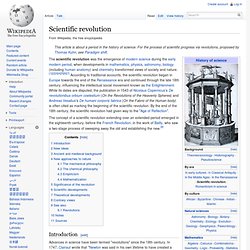
While its dates are disputed, the publication in 1543 of Nicolaus Copernicus's De revolutionibus orbium coelestium (On the Revolutions of the Heavenly Spheres) and Andreas Vesalius's De humani corporis fabrica (On the Fabric of the Human body) is often cited as marking the beginning of the scientific revolution. By the end of the 18th century, the scientific revolution had given way to the "Age of Reflection". Introduction[edit] Advances in science have been termed "revolutions" since the 18th century. The Counter-Reformation. First Vatican Council.
Drawing showing the First Vatican Council The First Vatican Council was convoked by Pope Pius IX on 29 June 1868, after a period of planning and preparation that began on 6 December 1864.[1] This twentieth ecumenical council of the Catholic Church,[2] held three centuries after the Council of Trent, opened on 8 December 1869 and adjourned on 20 October 1870.[1] Unlike the five earlier General Councils held in Rome, which met in the Lateran Basilica and are known as Lateran Councils, it met in the Vatican Basilica, hence its name.

Its best-known decision is its definition of papal infallibility. Papal infallibility[edit] Dei Filius[edit] On 24 April 1870, the dogmatic constitution on the Catholic faith Dei Filius was adopted unanimously. Pastor aeternus[edit] Protestant Reformation. Although the core motivation behind these changes was theological, many other factors played a part, including the rise of nationalism, the Western Schism which eroded people's faith in the Papacy, the corruption of the Curia, and the new learning of the Renaissance which questioned much traditional thought.

On a technological level the invention of the printing press proved extremely significant in that it provided the means for the rapid dissemination of new ideas. The Roman Catholic Church responded with a Counter-Reformation initiated by the Council of Trent and spearheaded by the new order of the Society of Jesus (Jesuits) specifically organized to counter the Protestant movement. In general, Northern Europe, with the exception of most of Ireland, turned Protestant. Southern Europe remained Roman Catholic, while Central Europe was a site of fierce conflict, escalating to full-scale war.
Religious situation in Europe[edit] History and origins[edit] Earlier schisms[edit] Counter-Reformation. A copy of the Vulgate (the Latin edition of the Catholic Bible) printed in 1590, after many of the Council's reforms had begun to take place in Catholic worship.
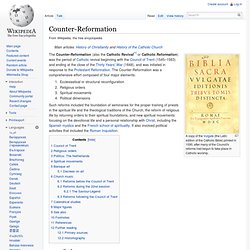
The Counter-Reformation (also the Catholic Revival[1] or Catholic Reformation) was the period of Catholic revival beginning with the Council of Trent (1545–1563) and ending at the close of the Thirty Years' War (1648), and was initiated in response to the Protestant Reformation. The Counter-Reformation was a comprehensive effort composed of four major elements: Ecclesiastical or structural reconfigurationReligious ordersSpiritual movementsPolitical dimensions Council of Trent[edit] A session of the Council of Trent, from an engraving.
Pope Paul III (1534–1549) initiated the Council of Trent (1545–1563), a commission of cardinals tasked with institutional reform, addressing contentious issues such as corrupt bishops and priests, indulgences, and other financial abuses. Religious orders[edit] Counter-Reformation. A copy of the Vulgate (the Latin edition of the Catholic Bible) printed in 1590, after many of the Council's reforms had begun to take place in Catholic worship. The Counter-Reformation (also the Catholic Revival[1] or Catholic Reformation) was the period of Catholic revival beginning with the Council of Trent (1545–1563) and ending at the close of the Thirty Years' War (1648), and was initiated in response to the Protestant Reformation. The Counter-Reformation was a comprehensive effort composed of four major elements: Ecclesiastical or structural reconfigurationReligious ordersSpiritual movementsPolitical dimensions.
Council of Trent. The Council in Santa Maria Maggiore church; Museo Diocesano Tridentino, Trento.